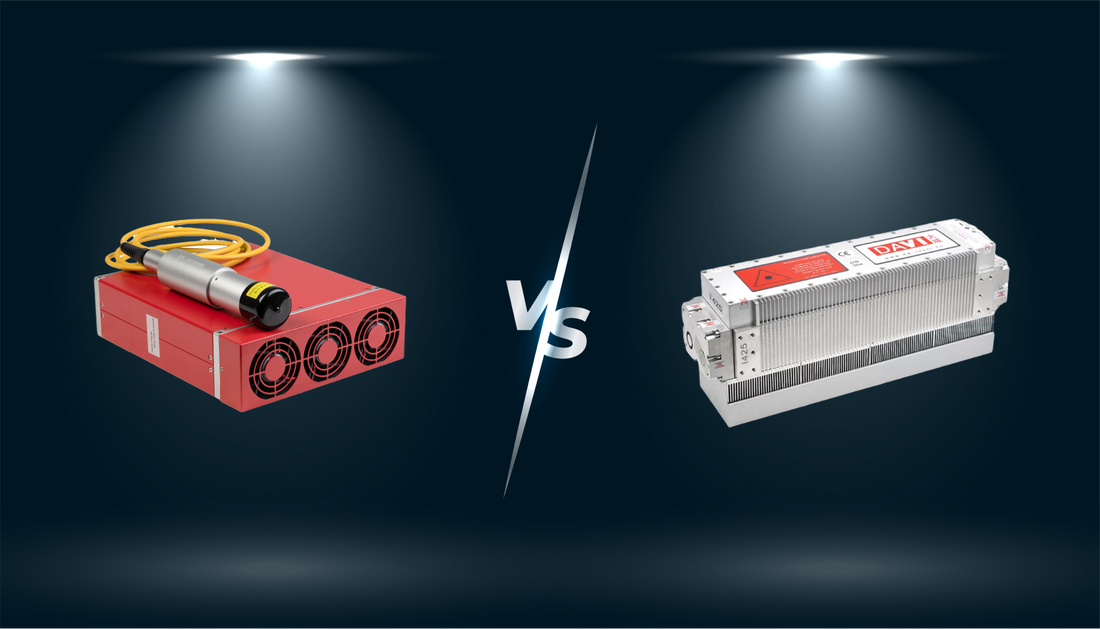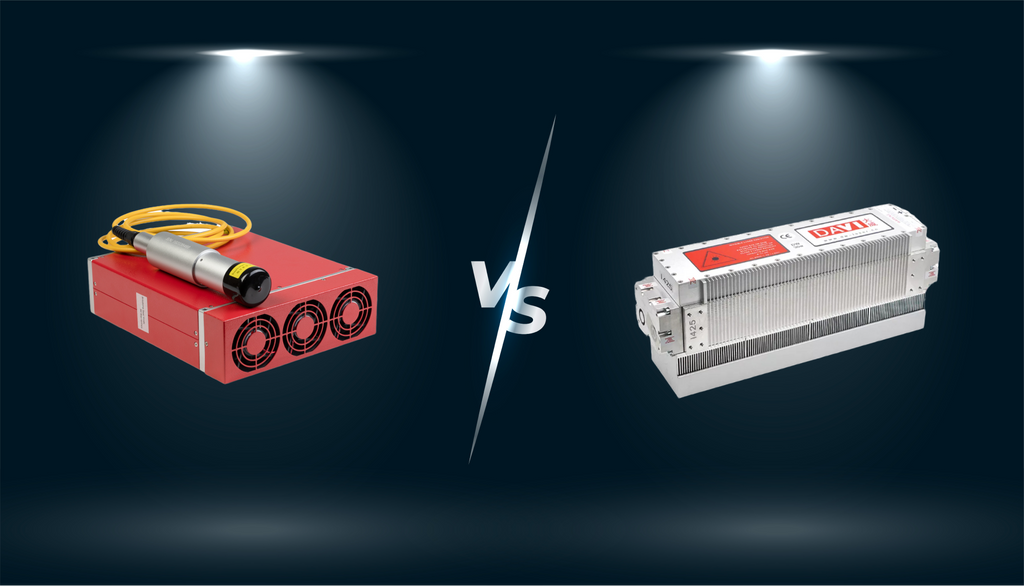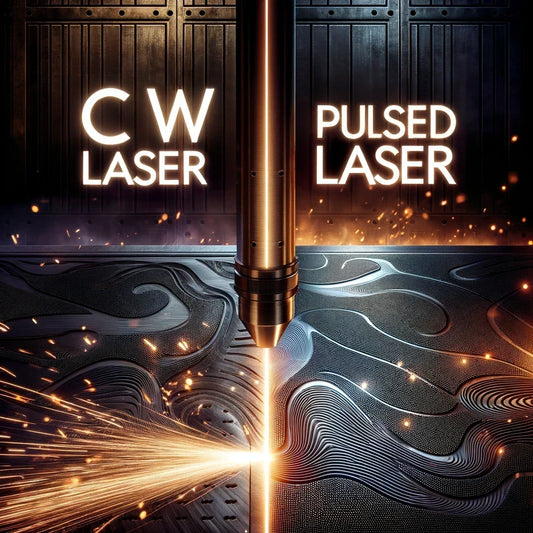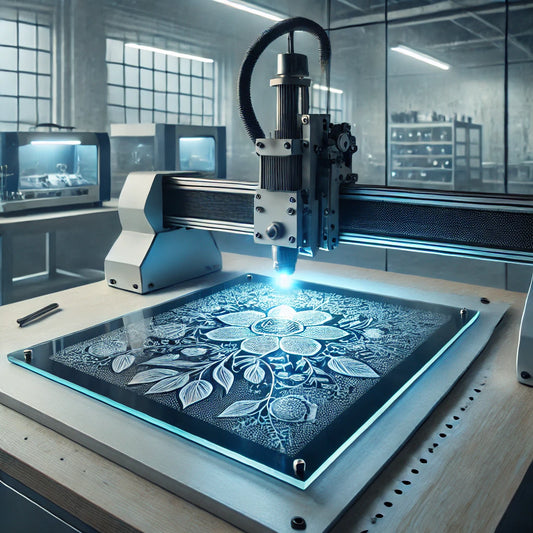
CO2 vs Fiber Laser: What to choose?

In the world of laser engraving and cutting, the two heavyweights are undoubtedly the CO2 and fiber lasers. Both tools have carved their niches and are renowned for their specific advantages. However, if you're standing at a crossroads, undecided about which machine to invest in, this guide aims to provide clarity. By understanding the workings, pros, and cons of each, and aligning these with your specific needs, you can make an informed choice.
How CO2 Lasers Work?
A CO2 laser, as its name implies, primarily uses carbon dioxide (mixed with other gases) for its lasing medium. Let's delve deeper into its mechanics:
Gas Mixture Composition: The heart of a CO2 laser consists of a gas-filled tube where the majority of the gas is carbon dioxide, usually supplemented with helium, nitrogen, and sometimes a bit of hydrogen, xenon, or water vapor. This blend plays a vital role in the efficiency and life of the laser.
Electrical Excitation: An electrical discharge is initiated in this gas mixture, which causes the gas molecules, primarily the nitrogen, to get excited. The excited nitrogen molecules then collide with CO2 molecules, transferring their energy in the process.
Production of Light: As the CO2 molecules return to their ground state from the excited state, they emit photons—particles of light. This light amplification, which is fundamentally the essence of any laser, leads to the generation of a very concentrated beam of light.
Amplification Through Mirrors: Inside the laser tube, one end typically has a mirror that's fully reflective, while the opposite end has a partially transparent mirror. As the photons bounce back and forth between these mirrors, they stimulate other CO2 molecules to decay to their ground state, leading to the emission of more photons. This chain reaction creates an amplification of the light produced.
Creation of the Laser Beam: The concentrated light eventually exits through the partially transparent mirror. This beam, with its high intensity, is what's used for engraving, cutting, or marking.
Wavelength Properties: CO2 lasers produce infrared light with a wavelength of about 10.6 micrometers. This specific wavelength is particularly adept at being absorbed by a variety of materials, making the CO2 laser versatile for various applications.
Cooling System: Given the heat generated during this process, CO2 lasers often require a cooling system. Smaller CO2 lasers can be air-cooled, but larger ones generally use a water-cooling system. Efficient cooling ensures longevity and consistent performance.
Beam Delivery: The emitted beam is often directed using a series of mirrors to its intended destination (the material to be cut or engraved). Some systems use a combination of mirrors and lenses to focus the beam more precisely, optimizing it for the task at hand.
How Fiber Laser Works?
Distinct from gas lasers like CO2, fiber lasers are categorized under the umbrella of solid-state lasers. The core component that makes fiber lasers unique is the 'doped' optical fibers. Let's explore the intricate details of its operation:
Optical Fiber and Doping: Central to a fiber laser's design is its optical fiber, which is 'doped' with a rare-earth element, typically erbium, ytterbium, or neodymium. This doping process increases the fiber's ability to amplify light.
Diode Emission: The operation kicks off with the emission of light from semiconductor diodes. These diodes serve as the initial light source and are crucial for the subsequent amplification process.
Light Capturing and Amplification: The emitted light from the diodes is channeled into the doped optical fibers. As this light travels through these fibers, it interacts with the doped particles. The excited rare-earth ions, as they return to their ground state, emit photons that are in phase with the stimulating light, leading to an amplification of the light within the fiber.
Laser Generation: Over the course of the fiber's length, this amplification process continues, generating a powerful and coherent laser beam by the time the light reaches the end of the fiber.
Beam Delivery: Once the amplified light exits the fiber, it can be delivered directly to the target material or may pass through a series of lenses to focus the beam, enhancing its precision and intensity.
Wavelength Specificity: Fiber lasers usually operate in the 1.0 to 1.1 micrometer range, making them particularly effective for metals, which readily absorb this specific wavelength, leading to efficient marking, engraving, or cutting.
Natural Cooling and Longevity: Fiber lasers are inherently more efficient than their CO2 counterparts, and much of their energy is converted directly into laser light, producing less heat. This means many fiber lasers don't require external cooling mechanisms. Moreover, the absence of moving parts and mirrors in their design leads to minimal maintenance and a longer operational lifespan.
Compact Design: Given that the lasing medium is the fiber itself, these lasers can be compact, allowing for flexible integration into various systems and applications.
Comparing CO2 vs. Fiber Laser Functionality and Capabilities
Wavelength and Material Compatibility
- CO2 Lasers: Operate primarily in the infrared region, around 10.6 micrometers. This makes them versatile for cutting and engraving a diverse array of materials, including wood, leather, plastics, glass, and textiles.
- Fiber Lasers: Typically emit at wavelengths around 1.0 to 1.1 micrometers, ideal for metals and some plastics. They're particularly known for their efficiency with metals like stainless steel, aluminum, brass, and copper.
Engraving Depth and Precision
- CO2 Lasers: Offer a broader range of engraving depths and are exceptionally good for softer materials. They can produce deep cuts or light etchings based on settings and material type.
- Fiber Lasers: Renowned for microscopic precision, especially on metals and harder materials. Their pinpoint accuracy makes them superior for tasks demanding intricate details.
Speed and Efficiency
- CO2 Lasers: Generally have a slower engraving and cutting speed compared to fiber lasers, especially on thicker materials. They might also require more frequent maintenance.
- Fiber Lasers: With their direct beam delivery and efficient energy usage, fiber lasers often work at faster speeds. Their solid-state nature and fewer moving parts also mean they generally have lower maintenance needs and operational costs over their lifespan.
Operational Lifespan and Durability
- CO2 Lasers: While sturdy, their lifespan can be somewhat shorter than fiber lasers, averaging around 10,000 to 20,000 hours, depending on usage and maintenance.
- Fiber Lasers: Boast an impressive operational lifespan, often exceeding 100,000 hours. Their solid-state design and absence of moving parts make them more robust and durable.
Beam Quality and Focus
- CO2 Lasers: Produce a larger beam wavelength, which can lead to a larger spot size when focused. This might not be as ideal for super-fine engravings.
- Fiber Lasers: Emit a smaller wavelength, which can be focused into an incredibly fine spot, achieving a high-intensity beam. This is why they're preferred for high-detail and high-precision tasks.
Operational Costs and Energy Consumption
- CO2 Lasers: Generally have a higher power consumption. Their need for external cooling systems and mirror cleaning can add to operational costs.
- Fiber Lasers: Known for their energy efficiency. Most of the power is converted directly into laser light, leading to lower energy costs. The absence of mirrors and the lower heat generation often result in reduced maintenance expenses.
Safety and Workspace
- CO2 Lasers: Given their larger footprint, they often demand a dedicated space. Some materials, when engraved or cut with a CO2 laser, can produce fumes that require effective ventilation.
- Fiber Lasers: Their compact design allows for more flexibility in workshop placement. While they produce fewer fumes than CO2 lasers, safety precautions, especially when working with metals, are still paramount.
Pros and Cons of CO2 and Fiber Lasers
In our exploration of CO2 and fiber lasers, understanding their respective advantages and disadvantages provides a comprehensive overview, enabling an informed decision-making process. Here's a deep dive into the pros and cons of each.
CO2 Lasers Pros & Cons
|
Aspect |
Pros |
Cons |
|
Material Compatibility |
- Versatile with a wide range of materials (wood, leather, glass, plastics, textiles). |
- Limited capabilities with metals without marking compounds. |
|
Technology Maturity |
- Long-standing presence in the market with vast resources and knowledge base. |
- Older technology may lack some modern enhancements. |
|
Cost |
- Affordable entry-level prices. |
- Can have higher operational costs due to energy consumption and maintenance. |
|
Finish Quality |
- Superior engraving finishes on organic materials. |
- Some materials might show inconsistent results. |
|
Maintenance and Longevity |
- Proven durability when well-maintained. |
- Requires regular upkeep due to mirrors and cooling mechanisms. Lifespan typically shorter than fiber lasers. |
|
Operational Footprint |
- Available in various sizes for different applications. |
- Generally requires more space, especially for ventilation and cooling systems. |
|
Energy Efficiency |
- Effective for its design and technology. |
- Less energy-efficient |
Fiber Lasers Pros & Cons
|
Aspect |
Advantages |
Disadvantages |
|
Material Compatibility |
- Specializes in metals with high precision and contrast. |
- Not as effective with certain non-metallics and organics. |
|
Technology Maturity |
- Advanced technology with ongoing innovations. |
- As a newer tech, might have fewer resources compared to CO2 in some contexts. |
|
Cost |
- Lower long-term operational costs due to efficiency and minimal maintenance. |
- Higher initial investment, especially for powerful models. |
|
Finish Quality |
- Delivers clean and high-contrast engravings, especially on metals. |
- Some materials might show inconsistent results or larger heat-affected zones. |
|
Maintenance and Longevity |
- Extended operational lifespan (often over 100,000 hours) with minimal maintenance. |
- Any damages might be costlier to repair given the advanced technology. |
|
Operational Footprint |
- Compact, allowing flexibility in workshop placements. |
- High-power models might still demand significant space. |
|
Energy Efficiency |
- Highly energy-efficient with most energy converted directly into laser light. |
- Though efficient, they might require specific power setups for optimal operation. |
Use Cases
When diving into the expansive world of laser technologies, understanding specific use cases is essential. Each laser type, be it CO2 or fiber, has carved out its niche in varied industries due to its unique properties. Let's explore the myriad applications that each laser excels in, showcasing their adaptability and utility.
CO2 Laser Applications
The CO2 laser, known for its versatility, shines exceptionally when handling non-metallic and organic materials. Its widespread applications range from the crafty corners of a hobbyist's workshop to the precision-required floors of manufacturing units. Here's how CO2 laser technology manifests its prowess.
Personalization and Customization
- Wood Engraving: From intricate patterns on wooden boxes to custom signage, CO2 lasers provide smooth finishes on organic materials.
- Leather Branding: For customized wallets, belts, and bags, CO2 lasers achieve crisp details.
Crafting and Hobbyists
- Scrapbooking: Cutting intricate shapes from cardstock or etching designs into scrapbook pages.
- Model Building: Precise cutting of thin wood or acrylic pieces for architectural or hobby models.
Fashion and Textile
- Fabric Cutting: Producing patterns for garments or cutting designs on fabrics.
- Shoe Designing: Engraving unique designs onto leather shoes or branding information.
Manufacturing and Production
- Plastic Prototyping: Creating models or prototypes by cutting and engraving plastics.
- Glass Etching: Personalizing glassware, awards, or designing decorative glass items.
Healthcare
- Medical Device Marking: Engraving identification or traceability data onto medical devices made of certain plastics.
Food and Beverage
- Edible Product Branding: Marking certain food items, like fruits, with branding or expiration dates.
Academia and Research
- Lab Equipment Labeling: Etching labels or barcodes onto glass lab equipment.
Fiber Laser Applications
Fiber lasers, renowned for their precision and efficiency in handling metals, have become indispensable in sectors demanding accuracy and durability. From the delicate craftsmanship in jewelry-making to the robust needs of aerospace, let's delve into how fiber lasers are revolutionizing different industries.
Industrial and Manufacturing
- Metal Engraving: Serial numbers, QR codes, or logos onto parts for traceability.
- Tool Marking: Engraving tools with identification details for automotive, aerospace, or machining industries.
Jewelry and Precious Metals
- Detailed Artwork: Crafting intricate patterns or inscriptions on jewelry items.
- Hallmarking: Legally certifying precious metal items with purity details.
Electronics and Gadgets
- Component Labeling: Marking PCBs, chips, or other electronics with essential information or branding.
- Device Personalization: Engraving personal messages or designs onto metal gadgets, like smartphones or watches.
Healthcare and Medical Devices
- Surgical Tools: Marking stainless steel surgical instruments with identification or traceability data.
- Metal Implants: Engraving relevant data onto titanium or other metal implants.
Automotive and Aerospace
- Part Traceability: Engraving parts with serial numbers or QR codes for tracking and authenticity.
- Component Branding: Applying branding or logos to metal components.
Security and Defense
- Firearm Marking: Applying serial numbers, branding, or design elements to firearms.
- ID Tag Creation: Producing durable, metal ID tags for personnel or equipment.
Energy and Infrastructure
- Pipeline Marking: Applying identification or safety information to metal pipelines.
- Component Labeling: Engraving energy or infrastructure components for traceability or safety compliance.
CO2 and Fiber Lasers Available on LasersOnly
|
Laser Type & Power |
Performance Characteristics |
Suitable Materials |
Applications & Use Cases |
|
- Moderate engraving speed. |
Wood, Acrylic, Leather, Glass, Fabrics. |
Hobbyist projects, Small signage, Fabric engraving. |
|
|
- Faster engraving speed. |
Wood, Acrylic, Leather, Glass, Plastics, Thin metals (with marking compounds). |
Professional engraving, Deep etches, Craft projects. |
|
|
- Precision engraving. |
Metals, Plastics, Reflective materials. |
Jewelry marking, QR codes, Lightweight machinery. |
|
|
- High-speed precision. |
Metals, Plastics, Reflective materials. |
Industrial marking, Metal engraving, Tool branding. |
|
|
- Enhanced depth and speed. |
Metals (including thicker ones), Hardened plastics. |
Deep metal engraving, Machine parts, Serial numbers. |
|
|
- Superior depth. |
All metals, Hard plastics, Ceramic, Silicon. |
Heavy industry, Aerospace components, Thick metal plates. |
|
|
- Extreme depth and speed. |
All metals, Ceramic, Silicon, Some gemstones. |
Deep engraving, Aerospace and automotive industry, Heavy machinery. |
|
|
- Maximum performance. |
All metals, Ceramic, Hard gemstones, Silicon. |
Thick metal cutting, Aerospace manufacturing, Large scale industrial projects. |
Both CO2 and fiber lasers offer distinct advantages, and the right choice largely hinges on your primary materials and desired applications. If your focus lies in diverse materials, especially non-metals, and you're on a tighter budget, CO2 lasers are a fantastic pick. However, if precision, especially on metals, is your top priority and you're viewing this as a long-term investment, fiber lasers, despite their higher initial cost, will serve you better in the long run.
By weighing the functionalities, benefits, and limitations of each against your specific requirements, you'll be well-equipped to make a choice that ensures both quality and efficiency for your projects.
*Image by starline on Freepik


